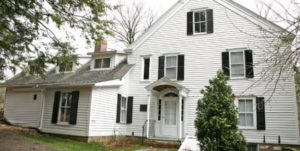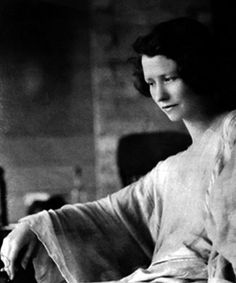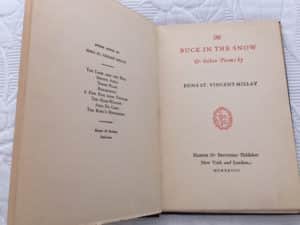I was in an antique shop, called Dappled Gray Antiques, in the downtown section of my suburb in St. Louis. The “dappled gray” came from a carousel horse in the window, and the shop was filled with both antiques and stuff that was old if not valuable. I ignored the stuff, antique or not, and found my way to the back, where the bookcases were filled with old books.
The books were generally of two kinds. Most obvious and most beautiful were sets from the 19th century, like Ulysses Grant’s Autobiography (published by Mark Twain), William Prescott’s three-volume Ferdinand and Isabella (eighth edition published in 1841), and Theodore Mommsen’s four-volume History of Rome (1868). The second category of books were fiction and poetry from the late 19th and early 20th century.
None of the books were outrageously expensive, as most were not first or even second editions. The Ferdinand and Isabella set was $75 and the Grant Autobiography was $35. The individual novels and poetry books, priced considerably less than the sets, were all hardbacks; the shop didn’t handle paperbacks.
Looking through the shelves, I saw a small, slim little volume entitled The Buck in the Snow and Other Poems. The poet was Edna St. Vincent Millay (1892-1950), and this volume was the sixth edition published in 1928. Looking at the printing history page, I could see that all six editions had been published in 1928, and all of them between September and December, with three printings in September alone.
Consider that a book of poetry had six printings in four months. Either the publisher, Harper & Brothers, had seriously miscalculated demand, or the collection had proven wildly and unexpectedly popular. Or both. Now consider the odds of a book of poetry being published today and going through six editions in four months.
I looked at the price of the book. Seventy-five cents. The condition was excellent; someone had taken good care of this little book. The someone’s name was even written on the inside cover page—Winifred Donlea. My imagination went into overdrive when I saw the name; I could imagine an elderly schoolteacher named Winifred Donlea who would insist that students and fellow teachers alike call her “Miss Donlea.” Then again, perhaps I was only channeling Jennifer Jones in Good Morning, Miss Dove.
I had read some of Millay’s poems in high school English classes, but I had never read her poetry in depth. The one poem I could easily recall was the short “First Fig, ” with the famous line about burning one’s candle at both ends. But with my new purchase for 75 cents (plus tax), I took Winifred’s book home and decided to learn more.

Steepletop, MIllay’s home in New York
Millay won the Pulitzer Prize for poetry in 1923 for The Ballad of the Harp Weaver, and by the time The Buck in the Snow was published five years later, she was a “presence” in American poetry. The years between the Pulitzer and The Buck in the Snow were occupied with writing more poetry, opera librettos, getting married, traveling, and moving to Steepletop, the home that’s most closely associated with her today.
While she was associated with Romantic poetry (and something called “women’s poetry”), Millay also epitomized, for some at least, the “new woman” who had emerged in the 1920s. She was generally shy but could also be outspoken and wasn’t afraid to speak her mind. Her reputation faded in the generation after her death until she was rediscovered as part of the feminism movement.
I’ve since read her Collected Poems, and one thing I can say is that she liked exclamation points. Her poetry exhibits a sense of life, perhaps a sense for life. She sees very clearly indeed with her poet’s eye. This is the title poem from the collection I found in the antique shop.
The Buck in the Snow
White sky, over the hemlocks bowed with snow,
Saw you not at the beginning of evening the antlered buck and his doe
Standing in the apple-orchard? I saw them. I saw them suddenly go,
Tails up, with long leaps lovely and slow,
Over the stone-wall into the wood of hemlocks bowed with snow.
Now he lies here, his wild blood scalding the snow.
How strange a thing is death, bringing to his knees, bringing to his antlers
The buck in the snow.
How strange a thing—a mile away by now, it may be,
Under the heavy hemlocks that as the moments pass
Shift their loads a little, letting fall a feather of snow—
Life, looking out attentive from the eyes of the doe.

Edna St. Vincent Millay
And what of Winifred Donlea? There is a reference to a Winifred Donlea, a resident Barrington, Illinois, by the Barrington Review for Nov. 8, 1928: “Miss Winifred Donlea of W. Main street and Miss Edna Anderson of Summit street spent Saturday in Chicago.” Another reference cites a Winifred Donlea, born about 1920, who married a man named Harrington and had a child in 1945.
If it’s the same Winifred Donlea in both references, she would have been about eight years old when she made her trip to Chicago (Barrington is a suburb). A little young, perhaps, to buy a book of poetry, but in the manner of sophisticated girls making a visit to the big city, perhaps it’s not too farfetched. I could easily imagine two little girls in a Chicago bookstore, looking for something appropriate to mark the trip in memory and Winifred seeing a display of Edna St. Vincent Millay’s new volume of poems.
It might have happened that way. But there’s no explanation for how the book ended up in an antique store in suburban St. Louis. And the shop itself closed some years ago.
But give me time, and I’ll think of a story.
Photo by Dirk Wallace, Creative Commons, via Flickr. Post by Glynn Young, author of the novels Dancing Priest and A Light Shining, and Poetry at Work.
__________________________

“I require all our incoming poetry students—in the MFA I direct—to buy and read this book.”
—Jeanetta Calhoun Mish
- Poets and Poems: Sandra Marchetti and “Diorama” - April 24, 2025
- Poets and Poems: Christina Cook and “Roaming the Labyrinth” - April 22, 2025
- Longfellow’s “Paul Revere’s Ride”: Creating a National Legend - April 17, 2025


Pat Durmon says
A universal experience with books in a bookstore. I often wonder about the previous owner with his/her name in the book. Always, I write my name under theirs because I know, one day, I’ll pass it on or someone will.
I enjoyed reading this. I identify with it.
Thank you for the offering at the beginning of my day.
Glynn says
Pat, thanks for the comment. Reading the owner’s name or the inscription is one of my favorite things with used books, even if I don’t buy the book.
Kevin O' Carroll says
Hello Glynn,
I assume you read my post about my mother, Winifred Donlea. I would love to have that volume of Edna St. Vincent Millay that once belonged to her.
Would you be willing to sell it?
Thank you so much.
Kevin Donlea O’ Carroll
ksocarroll@gmail.com
Sandra Heska King says
Hi, Pat. I don’t remember seeing you here before. But then my brain is a mite addled these days, so forgive me if I’m wrong. At any rate… I’m one of TSP’s baristas moving through the Mischief Cafe this morning with a teapot. Would you like some cinnamon toast. 🙂
And writing your name under the previous owner. What a great idea. Someone could write a great story about a book of several owners.
Laura (L.L.) Barkat says
“Consider that a book of poetry had six printings in four months.”
That made me smile.
And? Opera librettos? Who knew. 🙂
(You have such wonderful bookstore adventures!)
Glynn says
L.L., I always think of a bookstore as an adventure, and a used bookstore can be the best adventure of all.
Although, I have to say, I would not usually be looking for old opera librettos.
Bethany says
What a charming post. Love the way poetry, history, and imagination are woven together here.
Glynn says
Bethany – thanks for the comment! It was a fun post to do.
Prasanta says
A delightful adventure and story!
Bethany says
I agree, Prasanta – an internal and external adventure. 🙂
Sandra Heska King says
“Consider that a book of poetry had six printings in four months.”
I stopped to consider that, too. I love how your imagination travels on your adventures.
I remember reading Edna, but I have to go back and read her again to see what I remember. I know I don’t remember the Harp Weaver. But you know I had to go order that.
Laurie Klein says
Glynn, my next bookshop foray will be twice the delight for having time-traveled with you today. Thanks!
bkmackenzie says
She is one of my favorites of all time…bkm
Bethany R. says
bkmackenzie, just wanted to welcome you to the Tweetspeak Poetry community, if you haven’t been already. 🙂
Thanks for reading this and leaving your comment. Fun to hear that she is one of your favorites of all time. Are there any poems of hers in particular that you especially like?
bkmackenzie says
“What lips my lips have kissed, and where, and why”
Also I love her opening lines from “Renascence”
All I could see from where I stood was three long mountains and a wood.,,
Read her bio “Savage Beauty”. …bkm
Bethany says
Those are gorgeous lines, thanks for sharing them here.
Kevin Donlea O' Carroll says
Your story is a very personal gift for me and my family. Winifred Donlea from Barrington, Illinois is my mother. She often recited the poems of Edna St. Vincent Millay, Chaucer, Shakespeare and many other poets. My mother was a school teacher, a principal of public and private, primary and secondary schools and a university professor. She married two writers, Harry Thornton Moore and Edward Dahlberg.
When her first husband, Harry Moore, was a student at the University of Chicago he wrote for the student newspaper. One of his assignments was to critique a reading by Edna St. Vincent Millay. After turning in his article on Millay for publication the editor called him in and told him. “This is not a critique of the poems of Millay but a love letter.”
Harry and my mother, Winifred Donlea, were married on the First Day of Spring 1933 with the money Harry Moore was paid for his first published poem.
Winifred Donlea led a flamboyant and peripatetic life traveling and living all over North America, western Europe, and Africa. The character, Auntie Mame, from the book and the film, was somewhat like Winifred Donlea. She died in Cape Town, S.A. on the eve of her final destination which was Ireland where she planned to stay for the remainder of her life.
Barry says
Of course Harry Moore is none other than Harry Thornton Moore.
I’m trying to reach out to his children and descendants as I’m conducting research on Caresse Crosby. Harry was the executor of her literary estate.
If you have any contact information for your step siblings and cousins, I would be most grateful to receive it.
Best,
Barry O’Connell
Kevin O'Carroll says
Dear Barry O’Connell,
I will contact my half sister, who is the last living descendant of Harry Thornton Moore, and ask if it is alright to give you her contact information.
Are you Professor Barry O’Connell, who teaches at Amherst College? I briefly attended Amherst College in the mid 1970’s. The finest professors I have ever had the pleasure of meeting were teaching there.
I am the youngest son of Edward Dahlberg and Winifred Donlea O’ Carroll.
You are welcome to contact me directly:
Kevin O’ Carroll
ksocarroll@gmail.com
207-712-3012
Kind regards,
Kevin O’ Carroll